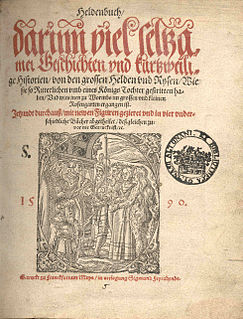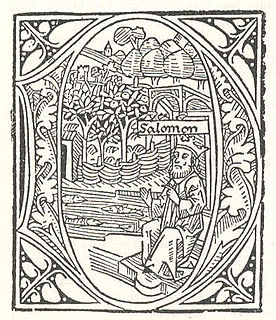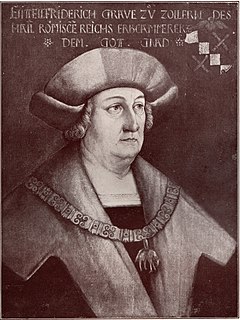The Lucidarius, an anonymous medieval book, was the first German language summa, [1] written circa 1190-1195. [2] It was based on different sources, the chief one being the Elucidarium and other texts by Honorius Augustodunensis. Other sources include De philosophia mundi by William of Conches and De divinis officiis by Rupert of Deutz. It has been preserved in 66 partial or complete manuscripts, and 85 printings in German. [2] It is claimed to be the first original German language work in prose. [3]
It was an introduction for laymen to the current religious beliefs and general knowledge, and was divided into three books; within the first book a description of the Creation and of the world in three parts, Asia, Africa and Europe. [4] The second book focused on Christianity and liturgy, with the third and final book centered on the afterlife and the Last Judgment.
The text has a prologue in verse, while the body is in prose, in the form of a dialogue between a student and his master. Different manuscripts of the text have different prose introductions, with one possibly slightly later version claiming that the text originated in Braunschweig under the impulse of Duke Henry the Lion. [1]
The book continued to be reworked and expanded in later versions, with generally more emphasis on the general knowledge and less on the religious aspects. A printed version from Strassburg from around 1534 was specifically intended for Protestants and used information from Sebastian Franck's Weltbuch from 1534. [4] Later printings, mainly from Frankfurt, followed this example, adding more illustrations and information. Parts from it were also used in Historia von D. Johann Fausten , the first Faust book.
Translations of the book appeared in Dutch, Danish, Croatian and Czech. [4]

Frederick I of Ansbach and Bayreuth was born at Ansbach as the eldest son of Albert III, Margrave of Brandenburg by his second wife Anna, daughter of Frederick II, Elector of Saxony. His elder half-brother was the Elector Johann Cicero of Brandenburg. Friedrich succeeded his father as Margrave of Ansbach in 1486 and his younger brother Siegmund as Margrave of Bayreuth in 1495.
This article presents lists of the literary events and publications in the 15th century.

In art history, "Old Master" refers to any painter of skill who worked in Europe before about 1800, or a painting by such an artist. An "old master print" is an original print made by an artist in the same period. The term "old master drawing" is used in the same way.

Heldenbücher is the conventional title under which a group of German manuscripts and prints of the 15th and 16th centuries has come down to us. Each Heldenbuch contains a collection of primarily epic poetry, typically including material from the Theodoric cycle, and the cycle of Hugdietrich, Wolfdietrich and Ortnit. The Heldenbuch texts are thus based on medieval German literature, but adapted to the tastes of the Renaissance.

Wolfdietrich is the eponymous protagonist of the Middle High German heroic epic Wolfdietrich. First written down in strophic form in around 1230 by an anonymous author, it survives in four main versions, widely differing in scope and content, and largely independent of each other.

On April 19, 1529, six princes and representatives of 14 Imperial Free Cities petitioned the Imperial Diet at Speyer against an imperial ban of Martin Luther, as well as the proscription of his works and teachings, and called for the unhindered spread of the evangelical faith.

Philip the Upright was an Elector Palatine of the Rhine from the house of Wittelsbach from 1476 to 1508.
The Soncino family was an Italian Ashkenazic Jewish family of printers, deriving its name from the town of Soncino in the duchy of Milan. It traces its descent through a Moses of Fürth, who is mentioned in 1455, back to a certain Moses of Speyer, of the middle of the 14th century. The first of the family engaged in printing was Israel Nathan b. Samuel, the father of Joshua Solomon and the grandfather of Gershom. He set up his Hebrew printing-press in Soncino in the year 1483, and published his first work, the Talmudic tractate Berakot, February 2, 1484. The press was moved about considerably during its existence. It can be traced at Soncino in 1483–90; Naples, 1490–92; Brescia, 1491–1494; Barco, 1494–97; Fano, 1503-6; Pesaro, 1507–20 ; Rimini, 1521–26. Members of the family were at Constantinople between 1530 and 1533, and had a branch establishment at Salonica in 1532–33. Their printers' mark was a tower.

Günther Zainer was the first printer in Augsburg, where he worked from 1468 until his death; he produced about 80 books including two German editions of the Bible and the first printed calendar. He came to Augsburg from Strassburg and printed in 1472–76 three large works of moral instruction. He also printed the first large illustrated book, Jacobus de Voragine's Legenda aurea in 2 volumes with 131 woodcuts, 1471–76. Johann Zainer, the first printer in Ulm, was probably his brother.

Guido de Monte Rochen or Guy de Montrocher was a Spanish priest and jurist who was active around 1331. He is best known as the author of Manipulus curatorum, a handbook for parish priests, that was often copied, with some 180 complete or partial manuscripts surviving, and later reprinted throughout Europe in the next 200 years, with at least 119 printings, and sales which have been estimated to be three times those of Thomas Aquinas' Summa Theologica. It became obsolete only when the Council of Trent created the Roman Catechism in 1566.

Johann Bämler was a printer, illuminator and bookseller from Augsburg, Germany.

Margaret of Bavaria was a princess of Bavaria-Landshut and by marriage Princess of the Palatinate.

Eitel Friedrich II, Count of Hohenzollern was a count of Hohenzollern and belonged to the Swabian line of the House of Hohenzollern. He was the first president of the Reichskammergericht. As a close friend of the Archduke and later Emperor Maximilian I, he gained great influence in the imperial politics. He managed to consolidate and expand his own territory.

Johannes Engel, also known as Johannes Angelus, was a doctor, astronomer and astrologer from Aichach, near Augsburg, which at that time was a Free Imperial City within the Holy Roman Empire. He practiced medicine in Vienna, and published numerous almanachs, planetary tables and calendars. His Astrolabium planum was published by Erhard Ratdolt of Augsburg in 1488; a second edition was printed by Johann Emerich for Lucantonio Giunti in Venice in 1494.
This page is based on this
Wikipedia article Text is available under the
CC BY-SA 4.0 license; additional terms may apply.
Images, videos and audio are available under their respective licenses.










